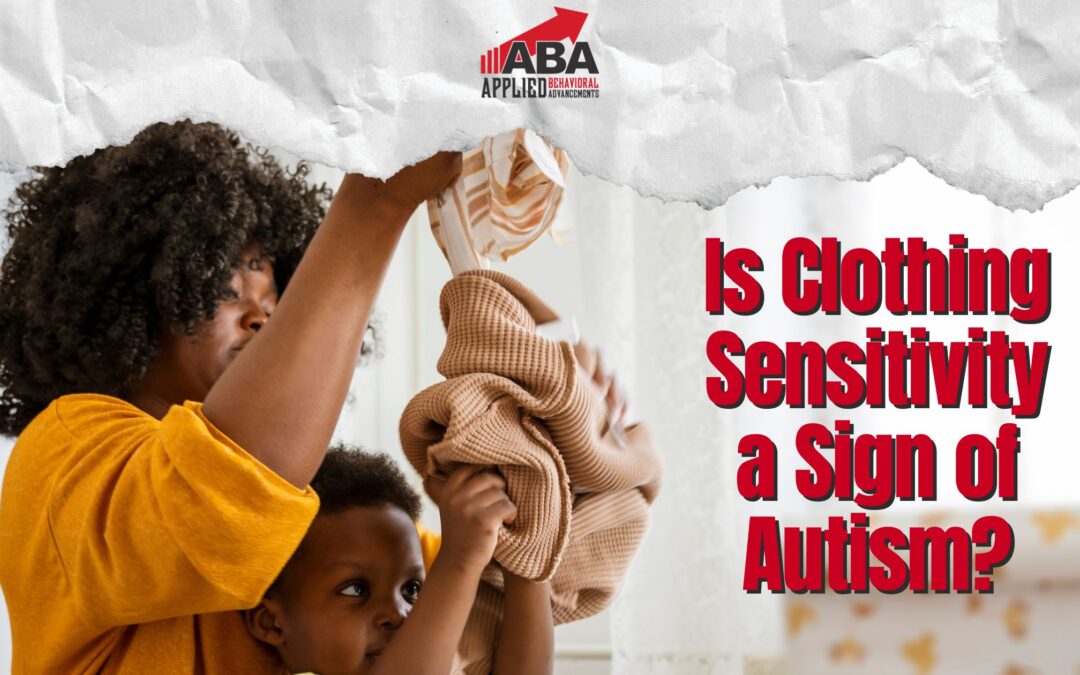Is clothing sensitivity a sign of Autism? Many people on the spectrum experience a heightened sensitivity. Finding comfortable clothing can be a frustrating experience day-to-day. Certain textures might feel scratchy, itchy, or otherwise uncomfortable. Seams and tags may irritate the wearer. While sensory sensitivity is a diagnostic criteria for an Autism diagnosis, having clothing sensitivity does not always mean a person is Autistic. Regardless of your diagnosis, you can use the tips in this article to navigate the discomfort you might be experiencing.
For more information about getting an Autism Diagnosis, please scroll down to the bottom of the article.
Sensory Sensitivity in Autism
Sensory sensitivity is a common symptom of Autism. It usually manifests in two different forms: “hypersensitivity” which refers to the experience of more heightened and intense sensory inputs, and “hyposensitivity” which refers to the experience of reduced sensory inputs. Both of these sensitivities can explain adverse reactions to different types of clothing.
When we understand that individuals on the spectrum experience sensory inputs differently, we can empathize when this leads to challenging behavior. After all, who hasn’t had the experience of becoming irritated by a certain repetitive sound and then lashing out? Our bodies have thousands of nerve endings that send signals to the brain, affecting our behaviors.
With patience and the right tools, a person can learn appropriate responses to sensory stimuli. However, not all sensory issues need attention, if they are not causing harm to the individual or those around them. Identify the ways in which sensory processing issues affects you or your loved one, and make wise decisions about what steps to take in addressing them. Therapy is right for some people, while simple adjustments to what clothes you wear works for others.
Hypersensitivity
People who experience hypersensitivity might feel that their experiences are amplified. Sensations that are easily tuned out by someone neurotypical are overwhelming for someone with hypersensitivity. This can result in mental, emotional, and physical exhaustion.
Hyposensitivity
Hyposensitivity affects the individual’s ability to process things like temperature, noise, and even hunger cues. A person with hyposensitivity might not know why its too hot to wear their coat, or understand that they’re being too loud for the environment they’re in.
Sensory Seeking & Sensory Avoidance
Individuals on the spectrum may perform certain behaviors with the goal of adjusting their sensory inputs. You have probably heard the term ‘Stimming,’ before, which refers to a common form of sensory seeking that helps an autistic person “balance” the inputs they’re receiving. Conversely, sensory avoidance is where a person goes to great lengths to avoid experiencing certain sensory inputs.
Sensory Overload
If a person on the spectrum receives too much sensory input, either all at once or building up over time, they might experience what is known as “Sensory overload.” In overload, all of the brains energy is focused on sensory processing, which may inhibit other functions like speech.
Common Areas of Clothing Sensitivity
If you personally experience clothing sensitivity, you probably are aware of your own discomfort in your clothing. But how do you know if a loved one is experiencing clothing sensitivity? Especially if said loved one is nonverbal or struggles with communicating their thoughts and feelings. Remember – just because something isn’t uncomfortable for you, doesn’t mean you can rule out the fact that its uncomfortable for your loved one. Even “comfortable” fabrics like cotton might feel scratchy to your loved one. You might think that they’d prefer to wear something loose, when actually, your loved one craves clothing that provides light compression.
Every person is unique, and will have their own preferences. However, to get you started on learning more about what may be causing the issue, here are several common factors that might be impacting your or a loved one. Get curious about preferences surrounding clothing!
Textures & Fabric
Every material has its own unique feeling, and it’s natural to develop preferences over time. Though some fabrics have a reputation for feeling “itchier” than others, remember that an autistic person’s sensory processing can differ from that of a neurotypical person, and even “soft” fabrics may feel different to them. Consider how you or your loved one feels about the different textures of these fabrics:
- Wool
- Velvet
- Microfiber
- Polyester
- Fleece
- Felt
- Denim
- Cotton
- Modal
- Viscose
- Organza
Tags
An irritating tag can ruin an otherwise perfectly good t-shirt! Though a lot of neurotypical people don’t notice the soft inner tags in their clothing, they can be very irritating for people with clothing sensitivity. Luckily, this is usually an easy issue to fix, as you can remove the tags yourself from most articles of clothing. Make sure to check if there is any valuable information about washing/drying an item on the tag before you throw it away!
Seams
Like tags, ill-placed seams can cause irritation in what is otherwise a perfectly good piece of clothing. Sometimes, flipping an item inside out so that the seams are on the outside of the garment (ie, not touching the skin of the wearer) is a possible solution. Especially for items worn beneath the skin, like underpants. Often, flat seams or seamless items are a better fit for those with clothing sensitivity.
Weight and Fit
The “way” something fits on a person’s body can have a major sensory impact. Some people prefer their clothes feel “light” and barely there. Another person might prefer something heavier, or thicker. Especially for some who struggle with hyposensitivity, heavy thick clothes might help them feel like they have more proprioception. Some people enjoy the sensation of tight, compressive clothing that feels like a “hug.” There are endless combinations of weight and fit that meets a persons different needs.
Additionally, ill-fitting clothing that fits too tight or too big can be uncomfortable for the wearer. It is normal for our bodies to fluctuate, and its important to check in with how our clothing fits regularly. What fit well six months ago may need to be replaced today!
Repetitive Wears
When a person has repeatedly experienced discomfort with clothes, they might choose a few pieces of clothing that feel “safe” and insist on wearing these pieces repeatedly. The familiarity and routine might provide a sense of comfort. However, with consistent wear, clothing might ware out quicker. Consider buying multiples of items that work well for you!
Sensory Friendly Clothing
Listed below are several “Sensory Friendly” or “Autism Friendly” clothing retailers. These clothes use research and data to understand common clothing sensitivities and meet those needs. However, its important to know that if you’ve met one person with autism, you’ve met one person with autism. So while these might be a great fit for one autistic person, they won’t be a great fit for everyone. Personal preference is more important than any “Autism Friendly” or “Sensory Friendly” label.
Another common suggestion for those who struggle with Clothing Sensitivity is to shop at thrift stores! Clothing from thrift store are often softer and more “well worn” than clothes that are purchased new. Plus – it’s a great fit for your wallet!
Managing Clothing Sensitivity
Managing clothing sensitivity comes down to knowing yourself and your own preferences. If you are helping a loved one with their sensitivities, pay attention to what they like and dislike about the clothing they prefer. It is possible to create a wardrobe that allows your loved one the peace they need to be comfortable day-to-day.
Should I embrace my loved one’s preferences?
You may be wondering – is it okay to reinforce my loved one’s preferences? Or should I push them to withstand discomfort and grow stronger? As long as your loved ones preferences are not harming you or your loved one, it is not imperative that you make them change their preferences. There are often easy, accessible solutions to Clothing Sensitivity issues. Embracing these preferences is a great way to affirm and celebrate your loved one’s autonomy. However, there are some situations where support for sensory issues is necessary…
When does my loved one need extra support?
There are nuances to every conversation. If your loved one’s preferences cause your family financial or emotional distress, are a consistent trigger to meltdowns, or pose a danger to your loved one’s safety in public spaces or in certain temperatures, it might be advisable to seek support and services. For instance – if your loved one has trouble wearing their coat during winter months, it is necessary to help them learn how to wear the coat so that they can stay safe and healthy in cold weather.
Clothing Sensitivity Support & Services
There are therapies designed to help with Clothing Sensitivity. If you already see a therapist, they will be able to make their own recommendations on what kind of therapy to seek out and from whom.
Occupational Therapist
An Occupational Therapist can tailor interventions that address your loved one’s specific sensory challenges. Some strategies might include desensitization techniques, adaptive strategies, and helping you learn playful strategies for helping your loved one get dressed.
Getting an Autism Diagnosis
Do you experience heightened sensory sensitivity? Do you struggle to understand common social cues? Are your interests considered “repetitive” or “obsessive” to the outside eye?
If you answered yes to these questions, or know a loved one who might fit this description, you might consider being tested for an Autism Diagnosis. For children, it is especially recommended to receive a diagnosis early so that they may receive services that help them stay on track with their neurotypical peers (early intervention), and receive certain aids and accomadations where applicable.
As an adult, receiving an Autism Diagnosis can be a validating experience that connects a person to a community of individuals with similar experiences, and empowers them with the tools they need for success. It may help you to receive certain aids or assistance programs. Choosing to be tested for Autism is a personal decision, but is not required for you to embrace coping strategies and an autistic identity.
You can seek an Autism diagnosis from a variety of qualified professionals in the mental health field such as psychologists, psychiatrists, or other developmental experts.
About ABA-LLC
ABA-LLC is one of the largest suppliers of Behavior Support in the State of Kentucky. Since 2007, the agency has created innovative strategies to improve the lives of unique individuals. ABA-LLC contracts with around 160 contractors, each dedicated to building an inclusive culture that celebrates individuals of all abilities. No matter who you are, you can reach your goals at ABA-LLC.
In everything the agency does, ABA-LLC is set apart from its competitors by its uniquely person-centered approach. The agency strives to provide services from a place of deep love for the population they serve. Their work exemplifies the belief that every individual has a right to live a fulfilling and independent life integrated within their communities. There is no objective to change a person, but rather to give them the tools they need to succeed. B.F. Skinner summarizes this vision in his quote: “I’m not trying to change people. All I want is to change the world in which they live.”

